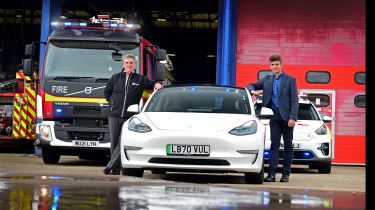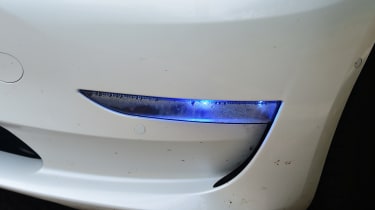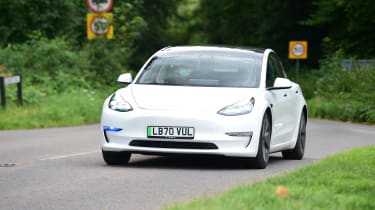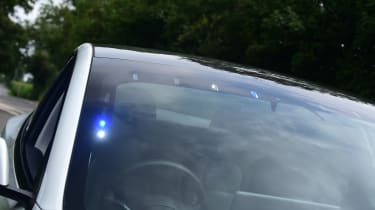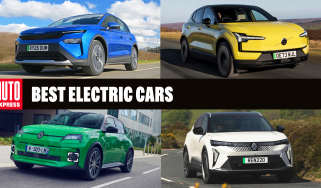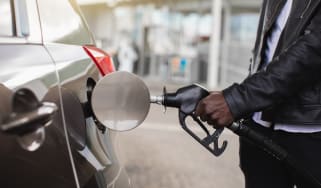Zero-emission emergency: The fire brigade that's switching to Tesla
We speak to the fire brigade looking to adopt Teslas across their flees and find out the challenges and opportunities of EV emergency vehicles
The transition to zero-emission vehicles affects a wide range of people and organisations, from private motorists and small businesses, to large corporations and fleets. Even emergency services are having to think about which vehicles they’ll purchase to renew their fleets in an eco-friendly manner.
However, with not just various practicalities to consider, but also cost-effectiveness – even more so when it’s taxpayers’ money at stake – it’s not as easy a task as one might assume. One fire brigade grappling with the dilemma is the Avon Fire & Rescue Service (AF&RS) which is trialling a Tesla Model 3 that has been specially fitted with sirens and blue lights to see if it would make a suitable addition to the service’s ancillary fleet.
AF&RS is especially keen to make the transition to zero-emission vehicles, because the councils in charge of Bristol and Bath are both implementing clean-air-zone restrictions. We visited the service’s technical centre in Avonmouth to find out more about the test and how it had gone.
The challenges of electrification
AN experienced fleet manager who formerly worked for Royal Mail, Brian Harwood is AF&RS’s head of transport. He explained that cars on the service’s ancillary (non-firefighting) fleet traditionally need to serve for 10 years before being sold on, and they also have to fit within a number of financial constraints. At present, the budget Harwood has to work with is geared much more towards petrol and diesel cars than electric vehicles, with the latter generally costing more to buy new.
“Part of the journey [to zero emissions] is for me to identify how leasing can help us,” Harwood explained. “Can we take a five-year lease? Does this work cost-effectively for us? How does this model work out if we do that?”
When Harwood was investigating options with various leasing companies and manufacturers, he discovered that Tesla had created a Model 3 with blue emergency service vehicle lights fitted.
With internal combustion-engined cars, a fire service can fairly easily fit blue lights, radios and other emergency equipment, but an inherent difficulty with electric vehicles is tapping into the high-voltage systems. “As you can imagine, 600 volts isn’t the ideal thing to be playing with,” said Harwood.
AF&RS has a replacement plan set for 2022/23, when around 20 to 30 vehicles – around half of its ancillary fleet – will be reviewed and replaced. This fleet of cars and vans supports a fleet of 34 fire engines, and can be used by a wide range of members of staff across the fire service, but one of the key uses is for a fire officer. Once a fire engine has been deployed to an emergency response, these managerial-level staff will follow on in an ancillary fleet car to take command. At the moment, AF&RS mainly uses Skoda Octavias for this job.
Officers’ cars need to make sense financially and also be large enough to carry lots of equipment. The service already has a handful of Kia e-Niros on its ancillary fleet, and these experience a 60-per-cent drop in residual values after four years, according to Harwood’s calculations. Range is another point for him to consider, which the Tesla provided a solution to.
“We can’t take on an electric vehicle with a range of 180 miles, expect it to do a day’s work and then the officer parks it at home, before having to go on a protracted event later in the evening with the risk they can’t keep going,” Harwood told us. “The Tesla filled that gap, and gave us the vision of what could be.”
Nevertheless, Harwood believes that range anxiety is an unnecessary concern, with AF&RS’s data suggesting that its vehicles rarely cover more than 50 miles in a day. Every key fire station in its jurisdiction – which covers Bristol, Bath and North East Somerset and South Gloucestershire – has multiple EV chargepoints, enabling vehicle trials and for electric cars on the fleet to be charged.
In the Tesla
The Tesla that AF&RS trialled is a Model 3 Long Range saloon with one key modification – it’s been equipped with front and rear emergency lights, allowing it to carry out blue-light runs.
We rode shotgun with Ryan Abbott, a British Army veteran who is now a driving instructor for AF&RS. It’s his job to teach staff how to drive in response situations and, as such, he’s one of the only people in the service authorised to use blue lights and sirens when there isn’t an emergency.
On the outside, there’s no real way of telling that the Model 3 is an emergency-services vehicle – it’s finished in standard white paint with the usual 18-inch Aero wheels. Interestingly, this is how fire-service cars will increasingly look in the future – the traditional red paintwork is being abandoned because it fades over time and affects residual values. The only clue to this Model 3’s line of work is that the black windscreen surround near the A-pillars is slightly wider, due to the lights fitted there.
Inside, the changes are a bit more obvious. The boxy units housing the blue lights surround the windscreen – there is a slight impact on visibility, albeit not a drasticone. There is also a single additional button on the centre console for controlling the lights (which can be activated with the horn as well), next to a Halls Electrical plaque that shows who installed the system.
Harwood had explained to us that not a single officer who tried the Tesla on its trial had a negative thing to say – everyone was impressed, including one member of staff who previously hadn’t been convinced by electric vehicles. Abbott echoed these sentiments as we turned into a sharp corner on a motorway slip road.
“This is where the Tesla comes into its own,” he said. “You can come into this corner so fast and it just bites into the road – the centre of gravity is so low, it’s just immense.” Comparing the Model 3 with the usual combustion-engined cars he has driven extensively, Abbott described the Tesla as being “phenomenal”.
“In the ‘normal’ cars, you have to really make sure you get that speed right on to the approach,” he explained, adding that this is not something you have to worry about as much in the planted Model 3.
With that, we accelerated down the slip road, merged on to the M5 and found ourselves in a big lunchtime traffic jam – which was the perfect opportunity for Abbott to demonstrate both the Tesla’s ‘blues and twos’ (blue lights and two-tone siren) system, and the challenges emergency service response drivers face on the road.
Abbott provides a running commentary as he drives, a traditional training technique used by professional drivers, which explains how he is reading each and every vehicle – he knows exactly when to overtake or undertake, and when to stay put. We also see how drivers trying to pull out of the way can be blocked by territorial motorists who aggressively speed up to stop others merging in front of them.
As we turn off along a country lane and speed along at a brisk pace, we asked Abbott whether there are guidelines on how far over the limit a fire officer’s car can go on a blue light run, bearing in mind that a fire crew will already be on scene, so an officer doesn’t need to rush quite as much.
“Some brigades give guidelines, but we don’t,”Abbott told us. “We just say you must always be able to stop in the distance that you can see to be clear, which is Rule 126 of the Highway Code.”
We find it staggering how slowly some motorists react when Abbott activates his blues and twos. While some cars sensibly move out of the way, others seem totally unaware of our presence – one car sits directly in front of us for a full minute before noticing we’re there and moving aside. While the types of cars emergency services use is inevitably changing, from our time in the field it’s clear that some of the challenges rescue workers face are, sadly, likely to remain.
Electric overtakes petrol as next fuel choice for car buyers...
Find a car with the experts

